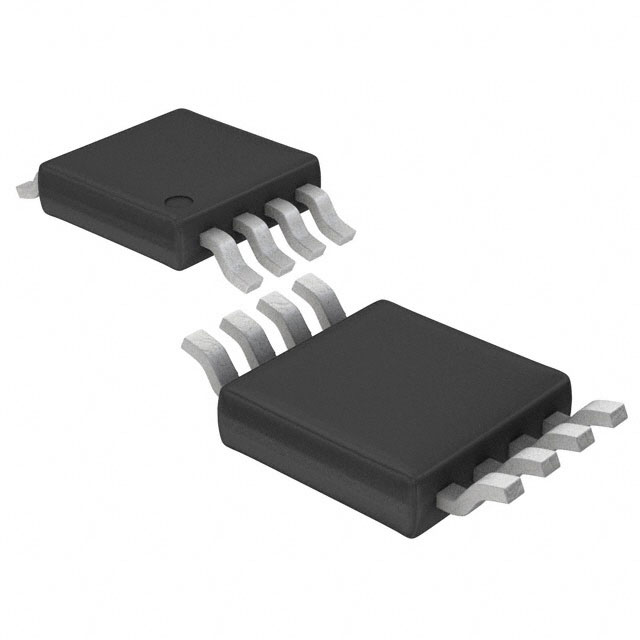Siehe Spezifikationen für Produktdetails.

LTC4300A-2IMS8#TRPBF
Product Overview
Category
The LTC4300A-2IMS8#TRPBF belongs to the category of I2C bus buffers and repeaters.
Use
It is primarily used for buffering and repeating I2C signals in various electronic systems.
Characteristics
- Low voltage operation: The LTC4300A-2IMS8#TRPBF operates at low voltages, making it suitable for modern low-power devices.
- High-speed operation: It supports high-speed I2C communication, enabling efficient data transfer.
- Bidirectional buffer: The device acts as a bidirectional buffer, allowing seamless communication between multiple I2C devices.
- Hot-swappable: The LTC4300A-2IMS8#TRPBF supports hot-swapping of I2C devices without disrupting the bus communication.
Package
The LTC4300A-2IMS8#TRPBF comes in an 8-pin MSOP package.
Essence
The essence of the LTC4300A-2IMS8#TRPBF lies in its ability to ensure reliable and robust communication between I2C devices by buffering and repeating the signals.
Packaging/Quantity
The product is typically available in tape and reel packaging with a quantity of 250 units per reel.
Specifications
- Supply Voltage Range: 1.65V to 5.5V
- Maximum Operating Frequency: 400kHz
- Quiescent Current: 1.5μA (typical)
- Operating Temperature Range: -40°C to 85°C
Detailed Pin Configuration
The LTC4300A-2IMS8#TRPBF has the following pin configuration:
- SDA (Serial Data Line): Input/output pin for the I2C data signal.
- SCL (Serial Clock Line): Input pin for the I2C clock signal.
- A1 (Address Input 1): Address selection input pin.
- A0 (Address Input 0): Address selection input pin.
- GND (Ground): Ground reference pin.
- VCC (Supply Voltage): Power supply pin.
- SDAOUT (Buffered Serial Data Output): Buffered output pin for the I2C data signal.
- SCLOUT (Buffered Serial Clock Output): Buffered output pin for the I2C clock signal.
Functional Features
- Bidirectional buffering: The LTC4300A-2IMS8#TRPBF buffers both the serial data and clock lines, ensuring proper signal integrity.
- Level shifting: It provides level shifting capability to accommodate devices operating at different voltage levels.
- Bus arbitration: The device supports bus arbitration, preventing bus contention and ensuring reliable communication between multiple devices.
- Fault detection: It incorporates fault detection circuitry to detect bus faults and isolate faulty devices from the bus.
Advantages and Disadvantages
Advantages
- Enables long-distance communication: The LTC4300A-2IMS8#TRPBF allows I2C signals to be transmitted over longer distances without signal degradation.
- Supports multiple devices: It facilitates communication between multiple I2C devices on the same bus.
- Hot-swappable: The device supports hot-swapping of I2C devices, allowing for easy replacement or addition of devices without interrupting the bus communication.
Disadvantages
- Limited maximum operating frequency: The LTC4300A-2IMS8#TRPBF has a maximum operating frequency of 400kHz, which may not be sufficient for certain high-speed applications.
- Requires additional components: To fully utilize the features of the LTC4300A-2IMS8#TRPBF, additional pull-up resistors and decoupling capacitors may be required.
Working Principles
The LTC4300A-2IMS8#TRPBF acts as a bidirectional buffer for the I2C bus. It monitors the SDA and SCL lines and buffers the signals to ensure proper voltage levels and signal integrity. The device also incorporates bus arbitration circuitry, which resolves conflicts when multiple devices attempt to communicate simultaneously on the bus. Additionally, fault detection circuitry is included to detect and isolate faulty devices from the bus, preventing disruptions in communication.
Detailed Application Field Plans
The LTC4300A-2IMS8#TRPBF finds applications in various electronic systems that utilize the I2C bus. Some of the common application fields include:
- Embedded Systems: The device is widely used in embedded systems where multiple I2C devices need to communicate with each other.
- Consumer Electronics: It is employed in consumer electronics such as televisions, audio systems, and home automation devices that rely on I2C communication for control and data transfer.
- Industrial Automation: The LTC4300A-2IMS8#TRPBF is utilized in industrial automation systems for interconnecting sensors
Listen Sie 10 häufige Fragen und Antworten im Zusammenhang mit der Anwendung von LTC4300A-2IMS8#TRPBF in technischen Lösungen auf
Sure! Here are 10 common questions and answers related to the application of LTC4300A-2IMS8#TRPBF:
Q: What is LTC4300A-2IMS8#TRPBF? A: LTC4300A-2IMS8#TRPBF is a dual bidirectional I2C bus buffer with low voltage level translation.
Q: What is the purpose of LTC4300A-2IMS8#TRPBF? A: LTC4300A-2IMS8#TRPBF is used to isolate two I2C buses, allowing them to operate at different voltage levels.
Q: Can LTC4300A-2IMS8#TRPBF be used for level shifting between different voltage domains? A: Yes, LTC4300A-2IMS8#TRPBF can be used to shift voltage levels between different I2C buses operating at different voltages.
Q: What is the maximum operating voltage range supported by LTC4300A-2IMS8#TRPBF? A: LTC4300A-2IMS8#TRPBF supports an operating voltage range from 1.65V to 5.5V.
Q: How many I2C buses can be connected using LTC4300A-2IMS8#TRPBF? A: LTC4300A-2IMS8#TRPBF can connect two I2C buses together.
Q: Does LTC4300A-2IMS8#TRPBF support clock stretching? A: Yes, LTC4300A-2IMS8#TRPBF supports clock stretching, which allows devices on the bus to hold the clock line low to slow down communication.
Q: Can LTC4300A-2IMS8#TRPBF be used in hot-swapping applications? A: Yes, LTC4300A-2IMS8#TRPBF supports hot-swapping, allowing devices to be added or removed from the bus without disrupting communication.
Q: What is the maximum data rate supported by LTC4300A-2IMS8#TRPBF? A: LTC4300A-2IMS8#TRPBF supports a maximum data rate of 400kHz.
Q: Does LTC4300A-2IMS8#TRPBF have built-in pull-up resistors? A: No, LTC4300A-2IMS8#TRPBF does not have built-in pull-up resistors. External pull-up resistors are required.
Q: Is LTC4300A-2IMS8#TRPBF available in other package options? A: Yes, LTC4300A-2IMS8#TRPBF is available in an MSOP-8 package as well.
Please note that these answers are general and may vary depending on the specific application and requirements. It's always recommended to refer to the datasheet and consult with the manufacturer for detailed information.

